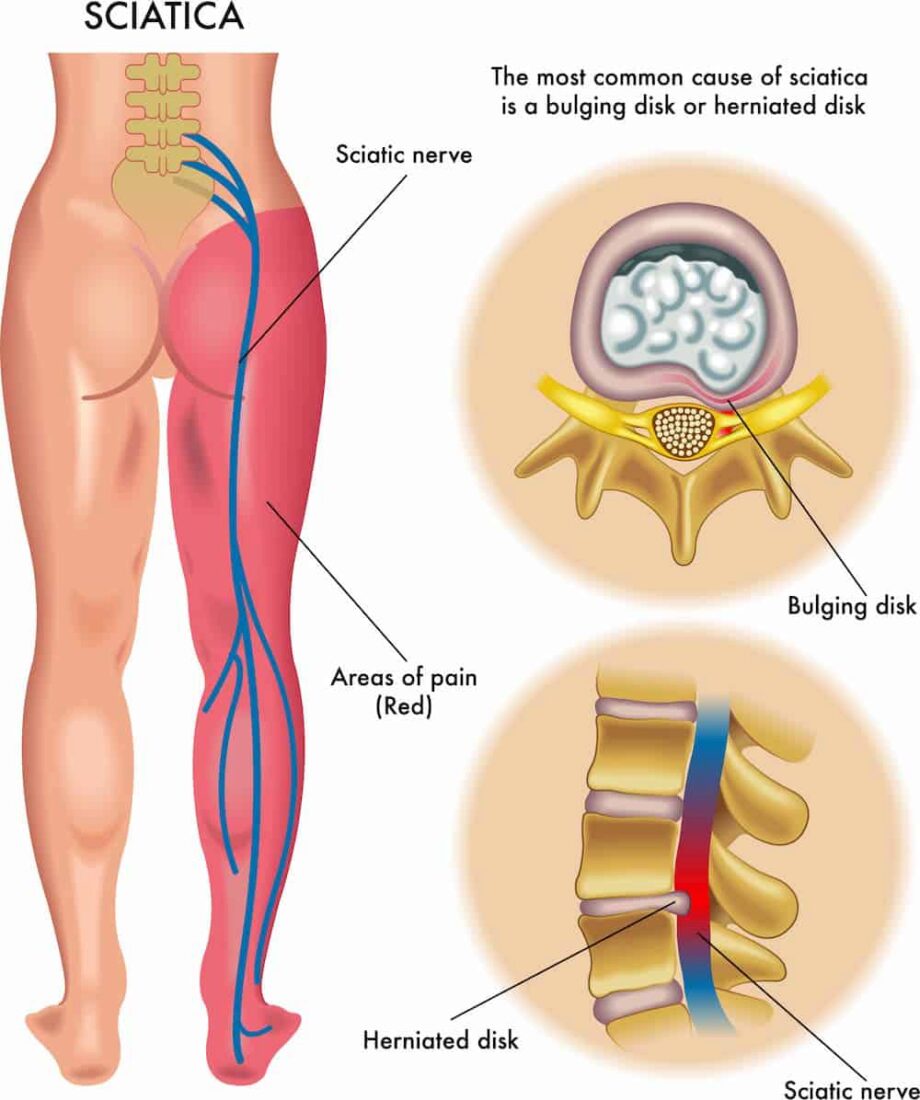Sleep and Sciatica
Disclosure: By clicking on the product links in this article, Mattress Nerd may receive a commission fee at no cost to you, the reader. Read full disclosure statement.

How Do I Know If I Have Sciatica?
The sciatic nerves are the two largest nerves in the body. They run from your lower back through your hips and buttock and down each leg. When the nerve becomes irritated, inflamed, pinched, or compressed, it can cause sciatica. Sciatica can be a real pain in the butt … or lower back. Or even the leg, calf, or foot. It’s a common ailment that affects as many as 40% of people at some point in their lives. Yet, sciatica is a rather misunderstood pain.
Sciatica usually occurs when the sciatic nerve becomes pinched by a bulging or herniated disk in your spine. In rarer cases, the pain can result from a tumor putting pressure on the nerve or damage to the nerve caused by diseases like diabetes. The location and intensity of your pain depends upon where the injury or damage is along the nerve and how bad the damage is. Sciatica pain has been described as dull, sore, numbing, jolting, throbbing, hot, stabbing, or radiating. The intensity can also vary from a slight nagging pain to severe and debilitating one.
Although sciatica is painful, it usually resolves within a matter of weeks. However, once you have experienced sciatica, you will likely have future episodes. In some cases, sciatica can lead to more serious problems.
Symptoms of Sciatica
Because the sciatic nerves affect several parts of the body, symptoms of sciatica can vary. Let’s look at some of the most common signs of sciatica:
- Lower back pain — The sciatic nerves start at the lower back and run along your hips and buttocks down each leg. It’s not uncommon to experience lower back pain caused by inflammation in the sciatic nerve.
- Pain radiating down butt/leg area — Pain that radiates from your lower back to your buttocks and down the back of your leg is the classic sign of sciatica. It is sometimes described as a shooting pain and usually occurs on just one side of the body.
- Pain while sitting — When you sit for prolonged periods of time, you put a lot of pressure on your glute muscles, lower back, and sciatic nerves. This can cause or worsen sciatica. If you have to sit for a while, get up every hour or so and walk around. This will get the blood flowing and help stretch out tightened muscles, and give those tender sciatic nerves a break.
- Hip pain — The sciatic nerves run through the hip joints and in some cases can cause pain to settle in the hip area. However, injuries in the hip joint can mimic the symptoms of sciatica. If you have hip pain that doesn’t improve in time, you may want to get checked out by a doctor to rule out other causes such as hip osteoarthritis, bursitis, or other conditions.
- Numbness — Some people with sciatica experience weakness in their legs and an altered sensation such as numbness. This is often caused by a herniated disc in the lower lumbar region of the back.
- Burning/tingling — Sciatica can also cause a burning or tingling like a pins and needles sensation particularly in the feet and toes.
- More severe symptoms can include — In rare cases, sciatic pain can be a sign of something more serious. For example, if the sciatica nerves at the base and just below the spinal cord in the lumbosacral spinal canal are affected, it could cause you to have symptoms such as urinary retention or urinary incontinence, or bowel incontinence. This is a condition known as cauda equina syndrome, and it is usually caused by a herniated disc but can also be caused by a spinal tumor, spinal stenosis, or a severe infection. Cauda equina syndrome can also cause numbness and tingling in the groin area and decreased sexual sensation. It is a serious condition that requires medical treatment. If left untreated, it can lead to permanent paralysis in the muscles of one or both legs.

Causes of Sciatica
There are several conditions that can cause sciatica:
- Degenerative Disc Disease — The discs of the spine are like cushions between each vertebral segment. When a disc deteriorates, it becomes susceptible to painful herniation. If a disc in the lumbar is affected, it can inflame the sciatic nerve.
- Spondylolisthesis — Spondylolisthesis is a painful condition in which the lower vertebrae slip forward onto the bone directly beneath it. If the vertebrae impinges the sciatic nerve root, it can cause classic sciatic pain.
- Muscle Spasms — Involuntary contractions of the muscles, or muscle spasms, can cause sciatica if they compress the sciatic nerve.
- Pregnancy — Sciatica is not uncommon during pregnancy. As your baby grows inside your belly, it can put pressure on your sciatic nerve and add to the usual aches and pains of pregnancy.
- Lumbar spinal stenosis — Lumbar spinal stenosis is the narrowing of the open spaces in the lower spine. When this occurs, it can compress and irritate your sciatic nerve.
Risk factors can include:
-
- Age — As you get older, your spine becomes more susceptible to herniated discs and bone spurs, which are leading causes of sciatica.
- Obesity — Excess weight puts added stress on your spine, which can inflame your sciatic nerves.
- Occupation — Jobs that require you to sit for long periods of time or do a lot of heavy lifting put added pressure on your back and increase your risk for back problems including sciatica.
- Prolonged sitting — Sitting on your bottom for hours on end puts pressure on your glute muscles and lower back, and aggravates your sciatic nerve, which is why couch potatoes are more prone to sciatica than active people.
- Diabetes — People with diabetes are at greater risk for nerve damage. When sciatic nerves are damaged, they can cause radiating pain from the lower back across the buttocks and down the legs.
Sleeping with Sciatica
Sleeping with pain can be challenging, especially radiating sciatic nerve pain which makes it difficult for you to find a comfortable sleeping position. Studies show that pain can interfere with sleep and cause a sleep deficit. Insufficient sleep can also reduce your body’s tolerance to pain and worsen inflammation. It can feel like a never-ending cycle.
“Many people with sciatica caused by a disc herniation wake up with increased symptoms,” says Dr. Jordan Duncan, owner of Silverdale Sport & Spine in Silverdale, Washington. “This is likely due to the fact that when we are recumbent for prolonged periods, for example during sleep, discs imbibe (draw in) fluid, which results in increased pressure within the disc, leading to more pressure on the nerve root.”
But there are some things you can do to lessen your pain so you can get a good night’s sleep, such as changing your sleep position, stretching, and practicing good sleep hygiene.
Sleeping Positions
- Sleeping on your back — This is considered the best sleeping position for sciatic pain because it eases pressure on the lower back and lumbar discs where the sciatic nerves are located.
- Sleeping on your side — Most people are more comfortable sleeping on their sides. This is a good position for sciatica sufferers because it doesn’t put direct pressure on your muscles, discs, or sciatic nerve. But, it is important that your mattress is supportive enough to keep your spine in alignment. For more support, try placing a thin pillow between your legs.
- Sleeping with your knees elevated — Sleeping with your knees elevated can help take pressure off your lower back. To achieve this position, place a pillow under your knees or, if you have an adjustable bed, use it to elevate the foot of your bed.
- Sleeping with a body pillow — Full body pillows provide extra comfort and help your body stay in a certain position throughout the night. These pillows come in a variety of shapes, sizes, and materials.

Stretches for Sciatica Pain
Stretching can provide some relief for sciatica sufferers. “The bottom line is that it’s important to do stretches like these to prevent pain by keeping ourselves limber, something I do, strive for and teach patients,” says Dr. Puja Shah, a double board-certified interventional pain management specialist and anesthesiologist at DISC Sports & Spine Center with locations in California. “Doing gentle stretches before bedtime, and after rising, can loosen the muscles and ligaments surrounding the spine and joints, helping to relieve symptoms of sciatic- or nerve-related pain.
- Reclining pigeon pose — This yoga pose opens the hips and eases lower back pain.
- Start by lying on your back with both knees bent.
- Lift your right leg and place your ankle on the top of your left knee. Hold the stretch for 15 to 30 seconds.
- Repeat steps with the other leg.
- Sitting pigeon pose — As the name implies, this stretch is similar to the reclining pigeon pose but is done in the sitting position.
- Start by sitting on the floor with your knees bent. You can keep your balance by placing your hands on the floor behind you.
- While seated, place your right ankle on the top of your left knee.
- Lean forward and move your upper body toward your thigh. Hold for 15 to 30 seconds.
- Repeat steps with the other leg.
- Forward pigeon pose — This is a more advanced version of the pigeon stretch.
- Begin in a plank or push up position.
- Move your right leg in front of you so that your right knee is toward your right wrist and your right foot toward your left wrist.
- Stretch your left leg out behind you. The top of your foot should be on the ground and your toes flat against the floor.
- Shift your weight forward onto your hands or elbows. You should feel a stretch in your right glute.
- Repeat steps with the other leg.
- Knee to opposite shoulder — This simple stretch is both easy and pain relieving.
- Lie on your back with your legs extended.
- Bend your right leg, grasp the knee and pull it toward your abdomen.
- Straighten your leg and then repeat these steps with your left leg.
- Do this three times on each side.
- Sitting spinal stretch — This stretch can help open the vertebrae to relieve sciatica pain.
- Sit on the floor with your legs extended.
- Bend your right knee so that your foot is next to the inside of your left knee. Keep your right foot flat on the ground.
- Move your left arm around so that your elbow is on the outside of your right knee. Place your right hand behind you for balance.
- Gently turn toward the right, looking behind you. Hold this position for 15 to 30 seconds.
- Repeat steps with the other leg.
- Standing hamstring stretch — This stretch can ease pain in the hamstrings.
- Stand and place one heel on an elevated surface, such as a dining chair.
- Fully extend your knee and flex your ankle by pointing your toes toward the ceiling.
- Bend forward at the hips making sure to keep your spine in a neutral position. Hold for 15 to 30 seconds.
- Repeat steps with the other leg.
Sleep Hygiene
Having good sleep hygiene helps prepare you for a good night’s sleep whether you’re suffering from sciatica or not. Here are some tips to help you improve your sleep hygiene so you can sleep better.
- Nighttime routine — Parents often establish a nighttime routine to help children unwind before bedtime. But it’s also beneficial for adults as well. Start your routine about 30 minutes before you plan to go to sleep. Here are somethings you can do to help you wind down before bedtime:
- Take a warm bath
- Listen to soothing music
- Meditate
- Read
- New mattress — An old, sagging mattress can worsen sciatica and can even strain the back. The best mattresses for sciatica pain combine contouring comfort to ease pressure points at the hips and shoulders with enough support to keep the spine in alignment. “Clearly the supportiveness of the mattress and the sleeping positions they adopt make a big difference on their pain levels and how difficult of a time they have in falling asleep,” says Alice Holland, a physical therapist with Stride Strong Physical Therapy in Oregon. “My advice is to make sure the spine is kept as neutral as possible when sleeping. What I mean by this is avoiding curvatures in the spine that are too extreme.”
- Eye mask — Artificial light can fool the mind (and circadian clock) into thinking it’s time to wake up. Keep out unwanted light all night long by wearing an eye mask.
- Comfortable, breathable PJs — You don’t want uncomfortable jammies keeping you up at night. Be sure your pajamas are loose fitting, soft, and made with breathable fabric, like natural cotton.
- Avoiding blue light too close to bed — Blue light emanates from the sun and even from unnatural sources like lamps and electronic device screens. It’s great during the day, helping boost attention, reaction times, and mood. But it can be disruptive at night. Dim lights and turn off electronics with screens at least 30 minutes before bedtime to help your body adjust to night time.
- Room temperature — Most people sleep better in a cool room. Experts say the optimal temperature is between 60 and 67 degrees.
- Avoiding strenuous exercise too close to bedtime — Exercise is a great way to burn off energy for a good night’s sleep. But working out too close to bedtime can interfere with sleep. That’s because exercise releases adrenaline which keeps your mind and body alert, and runs counter to falling asleep.
- Avoiding stimulants before bedtime — Caffeine and nicotine are stimulants. Enjoying them too close to bedtime can keep you from falling asleep.
Final Thoughts
Sciatica is a common ailment, and it can be a real pain. It occurs when there is damage to or pressure on the sciatica nerves. The pain can be mild or severe and can radiate from the lower back, through the buttocks and hips, and down the legs. Episodes usually ease up within weeks. Stretching or changing up your sleeping position may help ease your discomfort. But if your pain is severe or chronic, and if it prevents you from getting a good night’s sleep, you should talk to a medical professional.


